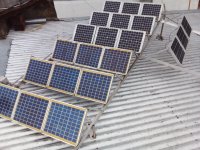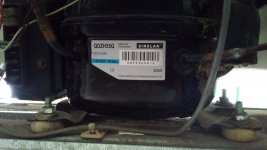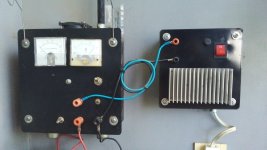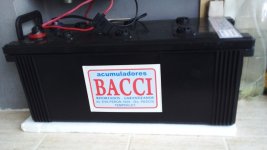About 5 years ago I bought myself a 50W solar panel setup, for no reason really than I wanted to play with a solar panel in the electronics hobby scope.
It worked fine in the window of my apartment and I used for about 2 years to charge my phone and other batteries.
It was when I screwed up my headphone amp virtual ground and coupled a load of noise onto it's power rails, I was rather bummed, until I decided to connect it to the ~12VDC from the solar panel battery. Total Silence. Could barely tell it was on. I was sold.
Since then I have upgraded the battery to a 100Ah marine SLA and moved it outdoors where I get the full 50W for about 8 months of the year if and its a big if, if it's sunny around noon. I also paid a spark £100 to run a 6mm cable up the outside of the house to the office so I can have direct DC power from garage solar battery to the electronics bench.
I even get away with cheating and using a little boost/buck converter (bench power supply) to additionally filter and stabilise the voltage to 16V. It's fuse at 10Amps, but above 3A it starts to drop noticeable voltage due to the 9 meter cable. The boost converter will run down to 6V though the battery won't!
I'm so sold on it that I'm upgrading it again to 300W 36V panel and 100Ah of LiFePO4 cells this spring. I might even get around to mounting the panel on the garage roof at least!
As for audio. Take a look around your audio setup and ask, what runs on a DC barrel jack or what "could" run on a DC feed alone. If all your stuff is valves and high power, look else where. If like me, almost everything runs on VDC direct from wall worts, the solar panel setup and battery will delivery silent power.
On going mains via an inverter. There are dragons. Finding a good "true sine" invertor that actual produces a true sinewave and not a bunch of high school willy drawings is a first hurdle. Then there is the rather dangerous and potentially lethal aspects of interconnecting two mains lines of different phase.
If you MUST have an invertor make it a remote sense grid tie invertor. At least that way the two mains feeds are in phase and the inverter will tolerate (or fight back against) back feed voltage. YMMV, consult a spark or a grey beard.
It worked fine in the window of my apartment and I used for about 2 years to charge my phone and other batteries.
It was when I screwed up my headphone amp virtual ground and coupled a load of noise onto it's power rails, I was rather bummed, until I decided to connect it to the ~12VDC from the solar panel battery. Total Silence. Could barely tell it was on. I was sold.
Since then I have upgraded the battery to a 100Ah marine SLA and moved it outdoors where I get the full 50W for about 8 months of the year if and its a big if, if it's sunny around noon. I also paid a spark £100 to run a 6mm cable up the outside of the house to the office so I can have direct DC power from garage solar battery to the electronics bench.
I even get away with cheating and using a little boost/buck converter (bench power supply) to additionally filter and stabilise the voltage to 16V. It's fuse at 10Amps, but above 3A it starts to drop noticeable voltage due to the 9 meter cable. The boost converter will run down to 6V though the battery won't!
I'm so sold on it that I'm upgrading it again to 300W 36V panel and 100Ah of LiFePO4 cells this spring. I might even get around to mounting the panel on the garage roof at least!
As for audio. Take a look around your audio setup and ask, what runs on a DC barrel jack or what "could" run on a DC feed alone. If all your stuff is valves and high power, look else where. If like me, almost everything runs on VDC direct from wall worts, the solar panel setup and battery will delivery silent power.
On going mains via an inverter. There are dragons. Finding a good "true sine" invertor that actual produces a true sinewave and not a bunch of high school willy drawings is a first hurdle. Then there is the rather dangerous and potentially lethal aspects of interconnecting two mains lines of different phase.
If you MUST have an invertor make it a remote sense grid tie invertor. At least that way the two mains feeds are in phase and the inverter will tolerate (or fight back against) back feed voltage. YMMV, consult a spark or a grey beard.
We have grid tied solar here, quite common.
We pay the difference - negligible at times - of power generated and power used.
40p per watt or so is the panel cost, Panasonic is more expensive, but 25 year warranty.
Look for old submarine or fork lift batteries, and a desulfator. Save you lots of money.
Also, there are many sites about off grid life.
Read up.
We pay the difference - negligible at times - of power generated and power used.
40p per watt or so is the panel cost, Panasonic is more expensive, but 25 year warranty.
Look for old submarine or fork lift batteries, and a desulfator. Save you lots of money.
Also, there are many sites about off grid life.
Read up.
I have off grid cabin with 200 watt solar panels and a 260 Ah AGM battery. With DIY 3255 amp and DIY loudspeaker i have wonderful sound. In the Norwegian mountains i have a very very low noise floor in my outdoor listeningroom 🙂




Solar cells are current cells escentially. They are amost useless except properly regulated and stored in a voltage source like a battery. Inverters are undesirable because of the internal consumption may be large. Below are mine. 24 cells 10Wpk each.
Attachments
Interesting take on full grid tie. It's really just "grid storage". This came to be from an electrical grid engineer. If you don't use it, someone else will and something wont have to generate it. When you want it back, hopefully the reverse happens. Down side is that financially the utility operator will **** you on the way in and the way out, totally dry.
And... it's just grid mains. Granted when solar is available your invertor will shout louder and most of your power will come from it. I expect you'll still see next door's Ethernet o' Mains though.
Battery and a decent MPPT charge controller, with a suitably sized (massive) inductor and caps or it will generate a load of noise when it's sunny 🙂
The question I have is whether to earth or continue to float the whole system. Floating is grand for zero noise coupling, but I'm still debating how screwed I am if it picks up charge in a lightening storm while wearing headphones and touch an earth.
And... it's just grid mains. Granted when solar is available your invertor will shout louder and most of your power will come from it. I expect you'll still see next door's Ethernet o' Mains though.
Battery and a decent MPPT charge controller, with a suitably sized (massive) inductor and caps or it will generate a load of noise when it's sunny 🙂
The question I have is whether to earth or continue to float the whole system. Floating is grand for zero noise coupling, but I'm still debating how screwed I am if it picks up charge in a lightening storm while wearing headphones and touch an earth.
this is a good pure sine wave inverter with low loss
https://www.victronenergy.com/inverters/phoenix-inverter-vedirect-250va-800va
https://www.victronenergy.com/inverters/phoenix-inverter-vedirect-250va-800va
Funny story. I discovered the mains leakage on the ground of my powered speakers as I had them connected to a solar powered headphone amp.... I was scoping the output and all I could see was about 16VAC mains with some audio modulated on it. Even more worrying though was if "I" touched the radiator pipe that fell to 2VAC. The powered speakers were floating the entire solar system and battery at 16V AC!
US NEC is pretty clear. All conductors must be bonded to dirt. Even aluminum siding. (There have been deaths when a nail hit a wire and nobody knew until the scream...)whether to earth
Obviously this is not enforced. And sitting here, I can touch four large shelf-brackets which are not grounded. That risk never crossed my mind. And I bet if I had our Inspector over, she would not cite it. Yes they are indoors, OTOH I have a LOT of wires criss-crossing behind PC and printers and router and lamp.
I'm in the UK, so if our electrical standards are such that if they were to apply to this I'd be screwed rightly! LOLUS NEC is pretty clear. All conductors must be bonded to dirt. Even aluminum siding. (There have been deaths when a nail hit a wire and nobody knew until the scream...)
The thing is, firstly the garage is classes as an un-adjoined outbuilding which lowers a whole load regulations. Like it only has a single skin brick wall and shallow foundations, where as the house is cavity block and brick walls.
All interior conductors must be bonded together and then bonded to the PE (protective earth). That would include any powered device which has exposed metal unless it's certified as a dual insulation device.
DC and low voltage are typically not covered much under the regs. Although I believe that low voltage lighting is now discouraged as the extra transformers hidden in dead spaces cause issues and fires and usually don't like LED lights.
So the spark who installed it clarified that he doesn't do DC, doesn't know any regs, but doesn't believe there are any regs for running 12V DC through an outdoor cable. So we both understand I have no come back. I know people who have done conversions to put in 24DC lighting circuits, so there are regulations to get it approved by building control, but I expect you'll pay for it as it's not exaclty high demand.
If it were a full invertor grid tie system running at hundreds of volts and pushing 4kW... it would need to be done to code and be certified or I would be liable.
As I am in the UK and all our plug sockets have earth connections, all it takes is to stick an earth conductor into a plug, plug it in and croc clip it to the solar panel +.
This is where you have to be careful. The solar system is common positive. So the safest way to ground it in isolation would be to connect the battery + to Earth. However. That means my 12VDC is actually -12VDC (referenced to earth) and should I ever connect that DC line to an earth referenced device like a scope or an earth reference audio amp, it's going to short the solar + and - together.
If however I earth the solar negative battery terminal, then the entire solar system's exposed metal will be at Earth +12VDC. I'm not fully away of the solar systems isolation properties, but as it "normally" floats a few volts from Earth I expect it not that great.
I need to consult grey beards again.
At my off-grid mountain cabin I have a 170W solar panel, a 100 Ah LiFePo4 battery and a Victron pure sine 800VA inverter. However, the thing on the pic below is a whole lot better. More power, and less noise. If you have an EV with V2L as I do (KIA EV6), I'd highly recommend using it.

I have concerns over V2L. Like:
I'm assuming with the right charger panel, you can hook this up like a Tesla power wall and use the car as a house battery.
- How does it effect the total cost of ownership of the vehicle, in terms of battery wear and tear?
- How environmentally advantageous is it when fully end to end calculated?
- Normally the state of the battery would be gleened from the car's mileage, however if the vehicle has V2L unless it has a regulated way to record the battery cycle life the value of the car will be significantly reduced without a full battery certificated test. You could be buying a vehicle that is only 3 years old, has only 20,000 miles on it, but has been running a house 10 hours a day for those 3 years and the battery is next to shot.
I'm assuming with the right charger panel, you can hook this up like a Tesla power wall and use the car as a house battery.
I only use the V2L when we are at the cabin, which happens around 15-20 weekends during a year. Use it for LED lights, charging phones, a small water pump, and occasionally a vacuum cleaner. Its very nice to have access to more wattage and capacity than the cabin's solar panel and battery can provide. During the winter, the sun is so low here in Norway, that there is no charging from the solar panel for at least 4 months mid-winter. We used to have a couple extra batteries, and brought them all home for charging. No need for that anymore. A weekend at the cabin usually takes about 10% off the EV's 77 kWh battery capacity.
You can't run a house with a EV's V2L, as it's limited to approx. 3 kW, and at full load it will last less than a day with a fully charged EV battery. It makes no sense either, because you'll have to recharge the car from the power grid. Well maybe, because electricity is cheaper at night. But then you'll need an EV with a large battery, and how much will that cost you compared to a lower electricity bill... ?
You can't run a house with a EV's V2L, as it's limited to approx. 3 kW, and at full load it will last less than a day with a fully charged EV battery. It makes no sense either, because you'll have to recharge the car from the power grid. Well maybe, because electricity is cheaper at night. But then you'll need an EV with a large battery, and how much will that cost you compared to a lower electricity bill... ?
I didn't know solar systems are positive ground. I never search for local regulations. Else I grounded negative because I'm using standard ham radio sets (Yaesu) that obviously are negative grounded because they are designed for both fixed and automovile use, and logically coaxil aerial, microphones and accesory wires are negative referenced. So taking positive to earth would become a big problem. Unnecessary problem.As I am in the UK and all our plug sockets have earth connections, all it takes is to stick an earth conductor into a plug, plug it in and croc clip it to the solar panel +.
This is where you have to be careful. The solar system is common positive. So the safest way to ground it in isolation would be to connect the battery + to Earth. However. That means my 12VDC is actually -12VDC (referenced to earth) and should I ever connect that DC line to an earth referenced device like a scope or an earth reference audio amp, it's going to short the solar + and - together.
And my humble 240W is completely isolated from mains, run on independent ducts inside wall structure. Excepting a transformer (Right box in the second pic) for recharging the battery after several hours of clouds blocking sunlight to prevent battery get severely discharged and damaged because my refrigerator is 12/24V natively and demands about 5Amper 40% duty cycle every day and night.
Attachments
Not all, just some.
It was also a surprise to a YouTuber "Van lifer" who's solar system burst into flames on them.
It was also a surprise to a YouTuber "Van lifer" who's solar system burst into flames on them.
IMHO inverters are undesirable. Including the best of them, the IGBT power is always prone to burn, and the internal current drain is an appreciable amount of the total full load demmand.
Once I saw 3 units of Omron 3 phase converters of 10,000 dollar each with final power stage burned and render it completely inoperative and un-repairable after a power grid failure. Too much money converted into thrash in few milliseconds.
Once I saw 3 units of Omron 3 phase converters of 10,000 dollar each with final power stage burned and render it completely inoperative and un-repairable after a power grid failure. Too much money converted into thrash in few milliseconds.
Looks great! Outdoor listening is the best. Very good natural diffusion.I have off grid cabin with 200 watt solar panels and a 260 Ah AGM battery. With DIY 3255 amp and DIY loudspeaker i have wonderful sound. In the Norwegian mountains i have a very very low noise floor in my outdoor listeningroom 🙂
View attachment 1131567View attachment 1131570View attachment 1131571View attachment 1131572
I just FFT'd my breadboard audio output. It's just an optical SPDIF board and a DAC.
No 50Hz spike.
It has to be lying to me. Surely.
Off grid DC for the win!
No 50Hz spike.
It has to be lying to me. Surely.
Off grid DC for the win!
- Home
- General Interest
- Everything Else
- Off grid solar for audio



